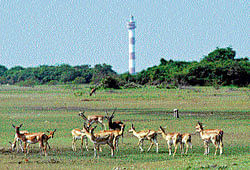
In a bid to strengthen its efforts at conservation of endangered plant and animal species, India has decided to initiate the country-specific red list of endangered species.
The red list of species under threat published by the International Union for Conservation of Nature (IUCN) is the best guideline for conservationists all around the world.
It is the referral index that points to the plants and animal species that are under looming threat of extinction and need protection.
India too has many species enlisted in the IUCN red list with the latest report indicating 57 animal species of India Critically Endangered (CR). But unfortunately, the country’s own database of wild species is in an appalling condition. ‘Data insufficient’ is all the information available on many species of India that are dying, sometimes even before their existence is known.
It is this void that the Environment Ministry of India has finally decided to fill. A high-level Environment Ministry panel has decided to bring its first report on the country’s endangered species, both plants and animals, by the end of next year.
“To begin with, two documents, one each on ‘Red list of Indian Plants’ and ‘Red list of Indian Animals’ would be released during the COP-11 of the Convention on Biological Diversity to be held in New Delhi in October 2012,” a Ministry document said.
The IUCN model
The red listing process would follow the guideline set by IUCN and would be a comprehensive list of species specific to India that need immediate attention and protection. The IUCN started preparing the red list of threatened species of animals and plants since 1963. The list is prepared on the basis of set criteria to evaluate the extinction risk of thousands of species and subspecies
These criteria are relevant to all species and regions of the world. For the Indian counterpart of the listing, many organisations across the country will be helping in the process but the data would be finally ascertained and published by the Botanical Survey of India and the Zoological Survey of India.
India is home to approximately 90,000 species of animals and 40,000 species of plants. From the northern boundaries of the Himalayas to the great coastal line of the south, from the vast Gangetic plains to the eastern and western ghats, the country is bedecked with many wonders of the natural world that make this nation stand out as a unique biodiversity hub of the world. And yet, while the country is plunging ahead as a force to reckon with in the 21st century, what it is essentially leaving behind is its natural treasure – the same 90,000 animal species and 40,000 plant species that are being bulldozed over each day to create a jungle, albeit a concrete one.
It is ironic that a country with a cache of historical knowledge of herbal medicines and one that is the birthplace of Ayurveda does not really care for its natural inheritance in the modern world. Barring the tiger and elephant, the peacock and mynahs, the neem and the banyan tree, Indians live in complete ignorance of the rich flora and fauna surrounding them.
Ancient knowledge of natural herbs and medicines seems to be becoming as endangered as the rare medicinal plants. While black bucks suddenly pop into limelight because of a star’s attempt to kill them, other animals like the Great Indian Bustard, the Tragopan, the Hangul, the pygmy hog are unheard of and therefore become unwanted.
Battle for survival
A bigger battle for survival is on for those species that are endemic to India. According to BSI, 33 per cent of plant species in India are endemic. As many as 44 species of Indian mammals, 396 higher vertebrate species, 55 bird species, 187 reptiles and 110 amphibians are confined entirely within Indian territorial limits.
In Karnataka alone, as per IUCN, 183 plants and 40 animal species are on the brink of extinction. Unique creatures like the lion-tailed macaque have no trees to leap to with humans infesting their forests. Same is the story of 246 plant species and almost 172 species of animals threatened in the rest of India by their greatest enemy, man, plundering the land that rightfully belongs to wildlife and pushing them into non-existence.
What the red list of endangered species of India can therefore do is bring those species of animals and plants that had been shoved into the background, into the public domain. It is a humongous task undertaken by the Ministry, considering the sheer diversity of this land, but once accomplished, it can eventually become the guiding light for many who wish to do more for the environment, but do not know how.
It can become a great educational tool for school children, researchers, farmers, technicians and nation builders. If ignorance has so far been the cause for extinction of precious species, the red list can now spark conservation.